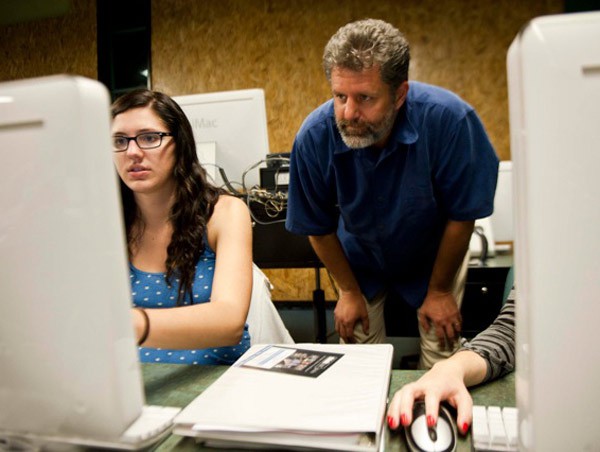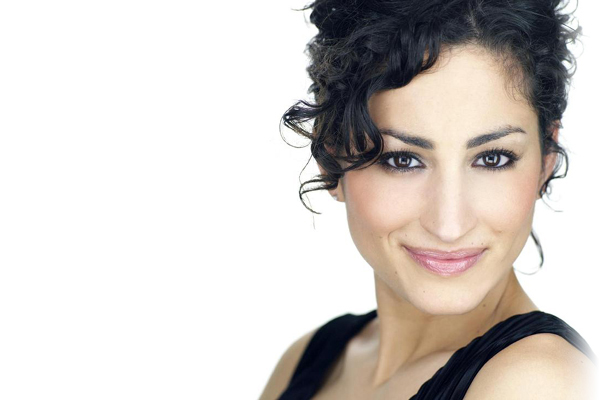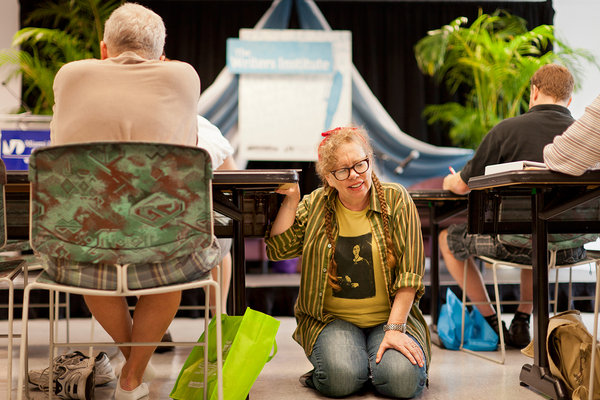Video #7 Get Social helps you plan for your interactions with the 800 million people on Facebook, 300 million on Twitter, and 400 million on Google+. The numbers sound daunting, but it doesn’t have to be – we’re not saying that every social media outlet will work for every photographer. But there’s enough evidence to suggest that a strong social media campaign can translate into real marketing exposure and revenue. Check out the video below for more.
Category: Technique & Workflow
-
Photo Business Plan Workbook Videos: #7 Get Social
-
Photo Business Plan Workbook Videos: #6 Tune-up Your Website
The best photography websites today aren’t just pretty displays for your pictures anymore. Now they’re full-blown sales and marketing tools that can host your photo archive, sell photography online, and more. Bottom line: they’re an integral part of your photo business. Allen’s video for #6 Tune-up Your Website is a good reminder of what a functional photo website must have in order to draw clients and customers.
-

Does Your Photo Website Have an Attitude Problem?
Does Your Photo Website Have an Attitude Problem? – PhotoShelter Blog
Joe Gosen, a Visual Journalism Instructor at Brooks Institute, is teaching a class on web design for photographers. From my perspective, college classes in web design always seem to be behind the times, arming students with knowledge that’s a touch out-da
via PhotoShelter Blog: http://blog.photoshelter.com/2011/12/does-your-photo-website-have-an-attitude-problem/?utm_source=feedburner&utm_medium=feed&utm_campaign=Feed%3A+PhotoshelterBlog+%28PhotoShelter+Blog%29
Joe Gosen, a Visual Journalism Instructor at Brooks Institute, is teaching a class on web design for photographers. From my perspective, college classes in web design always seem to be behind the times, arming students with knowledge that’s a touch out-dated, and are structured around “how it looks” than “how it works.”
But his class is different.
-
Designing a Better Portfolio Website: Part 2
In Part 2 of this series, we’ll discuss how to choose a template, modify it using basic HTML and CSS and add useful plug-ins. To quote Placeblogger C.E.O. Lisa Williams, “No journalism student should be intimidated by the process of setting up and managing a website — it is well within your ability, and it can all be learned and practiced before you graduate.”
-
Introduction to Digital Printing Part III
Introduction to Digital Printing Part III
By Ctein [Before we get started, a brief aside: My Minolta DiMAGE Multi Pro AF-5000 scanner has died and is in need of electronics servicing. Precision Camera no longer works on this model. If you know of someone in the…
via The Online Photographer: http://theonlinephotographer.typepad.com/the_online_photographer/2011/12/introduction-to-digital-printing-part-iii.html?utm_source=feedburner&utm_medium=feed&utm_campaign=Feed%3A+typepad%2FZSjz+%28The+Online+Photographer%29
The intended audience is those who haven’t done any serious digital printing but would like to. In other words, this is the introductory stuff (and, to pre-answer the question I know I’ll be asked again, no, there is not going to be a series on advanced printing). It doesn’t matter if you have wet darkroom experience or not. If you don’t have digital printing experience, this is for you
-
Designing a Better Portfolio Website: Part 1
This is the first of a three part series on how you can plan, design, build and maintain a successful photojournalism portfolio website. Part 1 focuses on planning your website
-

The Singular Approach: Chien-Chi Chang’s Contact Sheet Chronicle
LightBox | Time
Read the latest stories about LightBox on Time
via Time: http://lightbox.time.com/2011/11/16/the-singular-approach-chien-chi-changs-contact-sheets/#1
In 2006, Chien-Chi Chang—who throughout his career had exclusively shot 35mm format film—embraced a new photographic pursuit, to work with a medium format 6×7 rangefinder and began his ongoing project, Home. For the series, Chang purposefully shoots a single frame of his subject to build 9 frame contact sheets—chronologies that record his personal life as a travelogue and visual diary. Chang describes the series as “a documentation of my life with an effort to make every frame count.”
-
Stop it Down. Just a Bit.
Stop it Down. Just a Bit.
If you read much that I write, you know I love’s me some wide-aperture prime lenses. I like the narrow depth of field that isolates my subject, and the ability to shoot in low light. More than anything else, though, I love a nice sharp lens with superb re
via LensRentals Blog: http://www.lensrentals.com/blog/2011/11/stop-it-down-just-a-bit
The takeaway pont, though, is for many wide-aperture primes, stopping down slightly, just to f/2.0 or so, will dramatically increase resolution. For others, stopping down makes little difference, especially in the center of the image. Like everything else in photography, the more you know about the specific lens you are shooting with, the better you can use it.
-
Don’t Let Aperture or Lightroom Hold ’em All
On Twitter this evening, I talked a little bit about how to handle twenty bajillion photographs and stay afloat. My thinking on this has been shifting quite a bit over the last year and has been greatly influenced by conversations with others about the shoeboxes (or filing cabinets if we were a bit more sophisticated) we used to keep our archives in. Those thoughts aren’t yet complete and I’m not ready to write the big treatise on how my workflow really works, but I’m far enough along to at least give a sneaky peek on one aspect of it.
-
My tips on the Fuji X100
These are just personal adaptations I have made with the x100 to help my style of shooting in the streets of Mumbai.
-
‘Expose to the Right’ is a Bunch of Bull
‘Expose to the Right’ is a Bunch of Bull
By Ctein Got your attention, didn’t I? Unless you don’t know what I’m talking about. Lucky you. For those who haven’t been force-fed this bit of dubious dogma, “Expose to the right” is a rule that asserts that to get…
via The Online Photographer: http://theonlinephotographer.typepad.com/the_online_photographer/2011/10/expose-to-the-right-is-a-bunch-of-bull.html?utm_source=feedburner&utm_medium=feed&utm_campaign=Feed%3A+typepad%2FZSjz+%28The+Online+Photographer%29
For those who haven’t been force-fed this bit of dubious dogma, “Expose to the right” is a rule that asserts that to get the best quality in your digital photographs, you should push your exposure as far to the high side (the right side of the histogram) as you can without clipping the highlights.
-
10 Simple Ways to become a better Street Photographer by Eric Kim
The most beautiful thing about street photography is that you are able to capture real slices of life and capture them forever. Not only that, but street photography is open to everybody. You don’t need a fancy camera or expensive lenses to capture “The Decisive Moment”. All you need is passion and a curiosity of everyday life. If you ever wanted to learn how to become a better street photographer, read some of these tips below.
-
B&W Master Print
In the darkroom, a master was able to manipulate, through years of experience, the sense of presence by turning the flat Luminance image into the faux 3D Luminosity image. This is what Ansel was talking about when he talked about presence. To do this manually, in the darkroom, with primitive burning and dodging tools, requires intense complex technical and intuitive skill. Most photographers think that this inherent Luminance vs. Luminosity problem goes away with the advent of Photoshop and Lightroom. Nothing could be further from the truth. In fact, the problem is compounded, because we have more tools with which to create more mistakes and confusion.
-
Reminder: How to tune Photoshop CS5 for peak performance
This paper provides guidance on best practices to optimize Photoshop CS5 performance with a combination of careful hardware selection and informed program setup.
-
Size Doesn’t / Does Matter
Size Doesn’t / Does Matter
By Ctein The recent spate of camera announcements has brought forth many half-informed comments about sensor sizes and pixel counts. Let’s clear some stuff up. You can make great, as in fully professional quality, photographs with small sensors. I’m not..
via The Online Photographer: http://theonlinephotographer.typepad.com/the_online_photographer/2011/09/size-doesnt-does-matter.html
In summary, you don’t need a large sensor and you don’t need a lot of pixels. You can do serious photography of demanding subjects with a double handful of megapixels and a sensor the size of your pinky nail. As the title reads, size doesn’t matter.
On the other hand…
-
Am I A Photographic Cheat?
The dishonesty/deception argument is, I believe, based on the view that image editing distorts reality. We pretty-up the picture to make it more eye-catching. The finished product doesn’t “really look like” the scene that was in front of the camera. The breaking-the-rules argument is based on the related idea that the role of the photographer – especially a landscape photographer – is to present subject matter exactly as it really looked.
-

Perfect Landings: A New Angle on the Long Jump
LightBox | Time
Read the latest stories about LightBox on Time
via Time: http://lightbox.time.com/2011/08/31/long-jump-by-pawel-kopczynski/#1
Photographer and picture editor Pawel Kopczynski of Reuters explains how a combination of astute planning and specially developed remote camera technology produced a compelling series of photographs from the World Athletics Championships in Seoul, South Korea.
-

Photo assistant breaks down lighting from several famous photographers
It’s all in the lighting, baby!
“There is no object so foul that intense light will not make it beautiful.” ~Ralph Waldo Emerson I went a little crazy this week and went on a personal mission to research the lighting …
via Confessions of a Mad Photo Assistant: http://madphotoassistant.wordpress.com/2011/05/13/lighting-title/
In this blog entry I’ll take you through and compare various lighting techniques of Annie Leibovitz, Patrick Ecclesine, Jill Greenberg, Dave Hill and Martin Schoeller. Strap on your seatbelts boys and girls, it’s gonna be a long but thrilling ride. So without further ado, let’s dive right in shall we?


